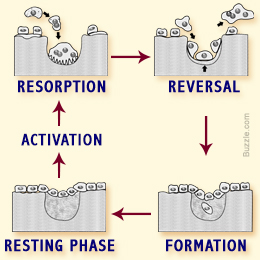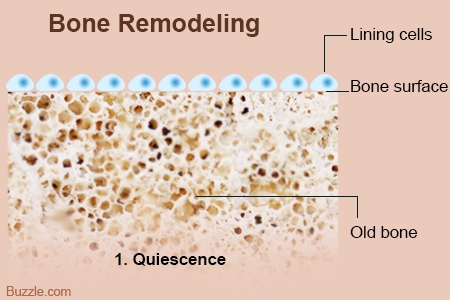Bones continuously undergo remolding, which includes replacement of an old bone with a new one. This process includes basically five stages: quiescence phase, activation phase, resorption phase, reverse phase, and formation phase. Let us discuss these stages in detail.
 Did you know?
Did you know?
20% of our bone tissues are replaced with the set of new bone tissues annually, through the bone remodeling process.Have you ever thought how our skeletal increases and shapes itself according to our age? How it grows in size and how it maintains itself? All these questions can be answered by understanding the process of bone remodeling.
Bone remodeling is a continuous and lifelong process of bone metabolism. It occurs on multiple sites simultaneously, and in this way, about 20% of our bone tissues get replaced annually. So, basically bone remolding is a process in which an old bone is replaced by a new bone. Remodeling plays a very important role in the development of bones. It also helps in maintaining the calcium level in the body and in repairing micro injuries.
The Process of Bone Remodeling
Bone remodeling consists of two major processes: Resorption (breaking or disintegration of the old bone) and ossification (formation of the new bone). Three types of cells play a very important role in the process:
- Osteoclasts: Osteoclasts are multinucleated cells. They are responsible for bone resorption. They travel to the sites of old bones or the bones which need to be repaired. They secrete acid phosphatase which disintegrate the bone.
- Osteoblasts: Osteoblasts are mononucleated cells. They help in the formation of the new bone. They secrete alkaline phosphate, which helps in the deposition of calcium and phosphate, resulting in the formation of a new bone.
- Osteocytes: Those osteoblasts which are not present on the surface of the bone are called osteocytes. They are found in the lacunae between the lamellae in a bone. These cells help in maintaining oxygen and mineral level in the bone.
After understanding the functioning of the cells that participate in the bone remodeling, let us discuss the bone remodeling process in detail. Though remodeling consists of two major processes, it can be divided into five steps.



1. Quiescence or Resting Phase
This is the initial resting phase. In this stage, all the lining cells which are actually inactive osteoblasts, keep themselves attached to the surface.
2. Activation Phase
Factors like micro-fracture, alteration in the release of substances like parathyroid hormone, insulin etc., activate the lining cells. These cells interact with the receptors which triggers pre-osteoclasts fusions and form multinucleotide osteoclasts. The osteoclasts gather on one site and form a small pit which is known as
Howship's lacunae.
3. Resorption Phase
As soon as the osteoclasts gather in the howship's lacunae, they start dissolving the bone. First they dissolve the matrix with the help of acidification and then they release lysosomial enzymes which help in the degradation of organic components of the bone. Once the bone is dissolved to the required extend, osteoclast undergo apoptosis or self-destruction. This is done to avoid excess resorption.
4. Reverse Phase
This phase is carried out by the revere cells, which behave as macrophage and remove the debris produced during resorption. Due to the bone resorption, several growth factors are released which recruit osteoblasts at the site of resorption.
5. Formation phase
Once osteoblasts generate in the resorption site, they start producing alkaline phosphate, which helps in the formation of new bone matrix, known as osteoid. Then they materialize and form a completely new bone. The surface of the bone again returns to its resting phase (quiescence phase) and this completes the bone remodeling cycle.
All the cells which help to conduct the process are regulated by hormones. Any imbalance in the production of hormones can directly lead to the imbalance in the resorption and formation process. This may affect the body mass and bone health. Bone remodeling in one of the most important functions of our body, which helps in maintaining skeletal health and even maintains calcium levels in the body. So, take care of yourself to help this process function properly.


 Did you know?
Did you know?

